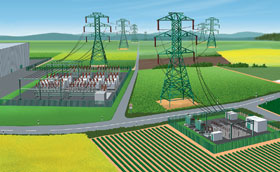The foundation of the Smart Grid
June 2014
Fieldbus & Industrial Networking

By Eric Byres and Tim Wallaert, Belden.
Over the past decade, two trends have converged that have caused many utilities to re-evaluate their substation communications infrastructure. One is the migration of the electrical grid from a reliable, but inflexible system to the ‘Smart Grid’, which promises adaptability and efficiency. It also requires the two-way communication of data, something that is not possible with traditional electrical grids.
The other trend is the increasing adoption by industry of Ethernet networking technologies for their communications. The ARC Advisory Group estimates that the adoption of industrial Ethernet networks is growing at a >12% plus CAGR (Compound Annual Growth Rate).
As a result of these trends, many utilities are faced with having to design and implement communication infrastructures that are unlike anything they have been involved with before.
If you are an engineer, field technician, manager or IT professional involved with such a project, you may be wondering where to begin. Alternatively, if you are working with an automation vendor or system integrator, you may want to become better informed to contribute to the project’s success.
To help, we have consolidated our learning and experience from assisting hundreds of customers around the world to design robust substation communications networks. The result is an easy-to-follow process that will guide you when designing new or upgraded communications systems. Here are the 10 best practices discussed in this white paper:
* Segment operational networks.
* Add serial communications devices to Ethernet infrastructure.
* The importance of Power over Ethernet.
* Time synchronisation.
* Selecting appropriate switches and routers for the environment.
* Building multiple layers of security.
* Adding communications infrastructure between master, backup and substations.
* Choosing the correct cables, jackets and connectors.
* Vendor selection.
* Good project management.
This white paper will walk you through each of the best practices, explaining the importance of each one and providing guidance on how to apply it to your needs.
To download the White Paper to a mobile device visit http://instrumentation.co.za/+C18945
For more information contact Greg Pokroy, Jaycor International, +27 (0)21 447 4247, [email protected], www.jaycor.co.za
Further reading:
EtherCAT interoperability removes industrial networking barriers
Fieldbus & Industrial Networking
Selecting the right communication technology is one of the most important decisions engineers make, and interoperability helps with that decision. Key development tools and standards ensure interoperability among many EtherCAT devices and manufacturers.
Read more...
Condition monitoring to go
Turck Banner Southern Africa
Fieldbus & Industrial Networking
Anyone who wants to efficiently monitor the climate in control cabinets will find a comprehensive range of control cabinet monitors for the DIN rail in Turck Banner’s cabinet condition monitoring family.
Read more...
Affordable building management system product range
Fieldbus & Industrial Networking
Schneider Electric has unveiled its EasyLogic Building Management System range, designed for basic building architectures, to the local marketplace. This is a complete and cost-effective range of field controllers and sensors that are both easy to install and scalable.
Read more...
Flexible EtherCAT communication interface for DALI-2
Beckhoff Automation
Fieldbus & Industrial Networking
The EL6821 EtherCAT Terminal from Beckhoff allows up to 64 DALI/DALI-2 slaves and 64 DALI-2 input devices to be connected. The TwinCAT 3 System Manager makes it easy to configure and parameterise DALI devices flexibly.
Read more...
EtherCAT-based control technology for building automation
Beckhoff Automation
Fieldbus & Industrial Networking
Modern non-residential buildings place many high demands on building automation. This can be optimally implemented with EtherCAT-based control technology from Beckhoff, which provides an efficient central automation architecture thanks to ultra-fast data communication.
Read more...
PC-based control for university studies
Beckhoff Automation
Fieldbus & Industrial Networking
The IDEA box developed at Heilbronn University of Applied Sciences is designed to introduce students to the topic of Industry 4.0 in a simple and practical way. At the core of the corresponding demo case is PC-based control from Beckhoff.
Read more...
A new standard in high-speed Ethernet communication
Fieldbus & Industrial Networking
The TXMC897 module from TEWS Technologies supports a range of Ethernet standards and speeds, making it suitable for diverse applications, including the defence, industrial, and IIoT markets.
Read more...
Data-driven battery production
Turck Banner Southern Africa
Fieldbus & Industrial Networking
The availability of high-performance batteries at moderate prices is one of the most important factors for the success of electromobility. As a long-standing automation partner to the automotive industry, Turck Banner supports the major battery manufacturers with its know-how.
Read more...
Bring critical temperature data to your condition monitoring system
Turck Banner Southern Africa
Fieldbus & Industrial Networking
Data conversion just got easier. Turck Banner converters are compact, simple add-ons that seamlessly fit into your factory applications. You can take various types of signals such as discrete, analogue and many others, and convert them to protocols like IO-link, PICK-IQ, PWM/PFM, and Modbus.
Read more...
Case History 190: Measurement problem ruins level control.
Michael Brown Control Engineering
Editor's Choice Fieldbus & Industrial Networking
The widely held belief in many plants that tuning will solve all base layer control problems is completely fallacious. Bad tuning is generally not the main reason for loops to perform badly. It is important when performing optimisation that all elements in a loop are considered, in addition to the control strategy, before even thinking of tuning.
Read more...

